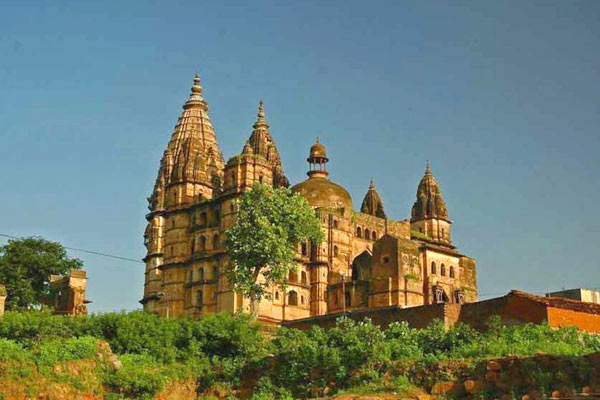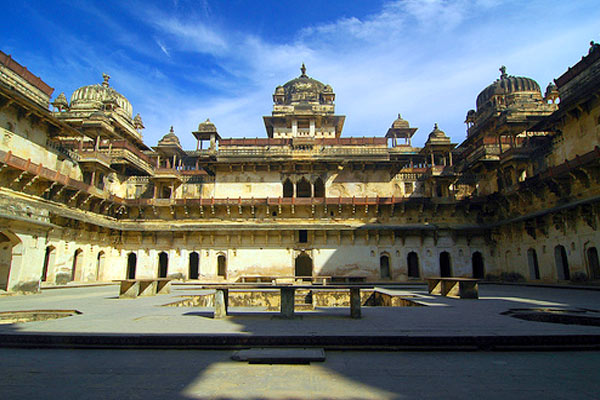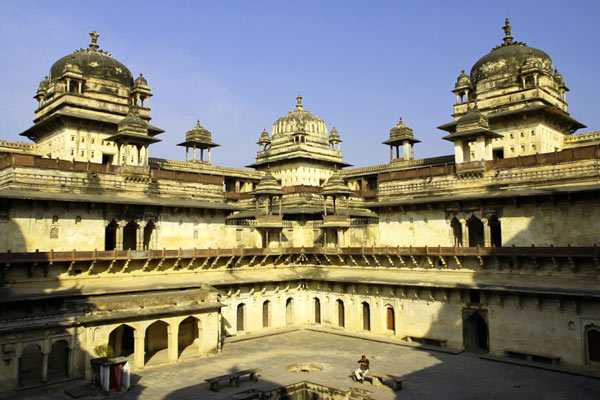Orchha, The kingdom lost in Obscurity.
General Information
District:TikamgarhState:Madhya PradeshCountry:IndiaArea:0Language Spoken:Hindi and englishLong Distance Code:+91-7680Importance:Ruins of Orchha FortBest Time To Visit:October to MayDescription:
An inevitable journey to Orchha while visiting Khajuraho to or fro Delhi is a delightful surprise. All the routes for Delhi to Khajuraho or Agra to Khajuraho go via Orchha. Orchha now nothing but a small tiny village, is one of those many villages of India which live in obscurity despite having great potential. Orchha some say means hidden, as the Rajput kings were pushed back from their Bundelkhand residence and they resorted to this place, there fore the name , Orchha.
Around 170 kms from the erotic temples of Khajuraho this small village must once have been a flourishing empire. The lost empire has left many of its impressions on this village. Situated on the banks of Betwa River, Orchha was founded by the Rajput Chieftain Rudra Pratap in the 16th century. Between 1531 to 1783 it remained the capital of the locally powerful Rajput Kingdom. The subsequent rulers after Rudra Pratap added many structures here which only enhanced the beauty of the previous ones, before finally shifting their capital to Tikamgarh.
The Fort of Orchha is what Orchha is all about. Though almost in ruins, still one can imagine the grandeur of the structure that it must once have been. The most notable king of Orchha was Raja Bir Singh Ju Deo. He built many palace and temples in the fort.
The most important monument inside the fort is the Jehangir Mahal, built to commemorate the visit of Emperor Jehangir to Orchha. The beautiful palace is built in tiers and is crowned by equally beautiful Chhatris on the top. The view from above is just stupendous. Built by Raja Bir Singh Ju Deo, this is the most exquisite palace of the fort.
The Raj Mahal gives a clear picture, of the royalty with which the kings lived. The Raj Mahal still holds some beautiful murals on the walls and the palace gives a spectacular view of the Jehangir Mahal and the Chaturbhuj temple.
This palace turned temple with its soaring spires and palatial architecture is one of the most unusual in India. The Ram Raja Temple, they say was built by accident. An idol of Lord Ram as brought from Ayodhya and installed in this palace initially till the temple was being built. But later on it became impossible to remove the idol and thus this to be palace was made into a sacred place. The actual temple where the idol was to be worshipped still stands as the Chaturbhuj Temple. Lotus emblems and other symbols of religious significance provide the delicate exterior ornamentation. Last but not the least is the Lakshmi Narayan Temple. The interiors are exquisitely beautiful as that of his exteriors. It contains some of the most beautiful murals and paintings of Orchha.
Apart from the famous landmarks the whole area is dotted with big and small shrines and cenotaphs which only add to the beauty of this small place.
 The Fort Complex is the main attraction of Orchha, it is located on an island on the Betwa River. There are three main palaces within the complex: Raj Mahal, situated on the right of the quadrangle. There is the Jahangir Mahal, built elaborately in commemoration of the Empwroe Jahangir. The final palace is the Rai Parveen Mahal, built in the name of the poetess and the musician whose love story is outstanding. The Orchha Fort is the center of the Orchha heritage and the narrator of the glorious past. An interesting thing about this place is that, Lord Rama is not considered as God like in the other parts of the country. They worship him as a great king. Best time to visit the complex is during the winter season, when the temperature decreases.
The Fort Complex is the main attraction of Orchha, it is located on an island on the Betwa River. There are three main palaces within the complex: Raj Mahal, situated on the right of the quadrangle. There is the Jahangir Mahal, built elaborately in commemoration of the Empwroe Jahangir. The final palace is the Rai Parveen Mahal, built in the name of the poetess and the musician whose love story is outstanding. The Orchha Fort is the center of the Orchha heritage and the narrator of the glorious past. An interesting thing about this place is that, Lord Rama is not considered as God like in the other parts of the country. They worship him as a great king. Best time to visit the complex is during the winter season, when the temperature decreases.Timings: 0800-1800 hrs
The Ram Raja Temple is a temple in Orchha, Madhya Pradesh, India. It is a sacred Hindu pilgrimage and receives devotees in large numbers regularly and is also commonly known as Orchha Temple. The annual domestic tourist number is around 650,000 and the foreign tourist number is around 25,000. The daily number of visitors to the temple range from 1500 to 3000 and on certain important Hindu festivals like the Makar Sankranti, Vasant Panchami, Shivratri, Ram Navami, Kartik Purnima and Vivaha Panchami the number of devotees who throng to Orchha range in thousands. In India this is the only temple where Lord Ram is worshiped as a king and that too in a palace. A Guard of Honour is held everyday, police personnel have been designated as Guards at the temple, much in the manner of a king. The food and other amenities provided to the deity at the temple are a royal repast. Armed salutation is provided to Lord Ram every day.
In the temple Raja Ram is accompanied by Sita (on the left), brother Laxman (on the right), Maharaj Sugreev and Narsingh Bhagwan (on the right). Durga Maa is also present in the darbaar on the right side. Hanumaan ji and Jamwant ji are praying just below Sita. The speciality of this temple is that Lord Ram has a sword in his right hand and a shield in the other. Shri Ram is sitting in Padmasan, with the left leg crossed over the right thigh.








